Gardens of Memory as Cultural Landscapes for Sustainable Destination Planning
Abstract
1. Introduction
- “[…] sorge or commosso il lauro, e tra le tombe
- non mai spento l’allor che a lui cresceva.”
- Santa Croce, a national pantheon of artistic and scientific greatness;
- The English Cemetery, a Romantic, cosmopolitan garden of mourning;
- The Florence American Cemetery, a transnational, landscaped memorial of 20th-century sacrifice.
2. Historical and Symbolic Framework of Commemorative Gardens
2.1. Classical Literature and Arboreal Symbolism: Cultural Roots of Contemporary Memorial Landscapes
2.1.1. Why Trees Matter: Classical Symbolism and Contemporary Spatial Design
2.1.2. The Laurel (Laurus nobilis): Poetic Immortality and Cultural Prestige
- “Laurel, you will grace the brows of Roman generals,
- be a loyal guardian at Augustus’ doorposts,
- and stand before the palace, watching over its halls.”
2.1.3. The Cypress (Cupressus sempervirens): Funerary Transition and Sacred Silence
- “We planted cypresses by the altars.”
2.1.4. The Oak and Holm Oak (Quercus ilex): Civic Virtue and Sacred Wisdom
“The most ancient oracle was that of Dodona, where people consulted the sacred oak of Zeus.”
2.1.5. Sacred Groves: Archetypes of Memorial Landscapes
2.2. The Saint-Cloud Decree and the Secularization of Memory
2.2.1. Death Moves Outside the City: From Ritual to Regulation
2.2.2. The Shift from Sacred to Civic Memory
2.2.3. Literary Resistance: Ugo Foscolo’s Dei Sepolcri
- “vivea per l’urna un nome”—“a name lived on through the urn.”
2.2.4. Nature Re-Enters the Scene: The Birth of the Garden Cemetery
2.2.5. Participatory Governance and Policy Frameworks in Contemporary Memorial Landscapes
- In Italy, the Codice dei beni culturali e del paesaggio (Legislative Decree 42/2004) recognizes historical cemeteries as cultural assets (beni culturali), subject to protection and eligible for valorization projects involving public–private partnerships, educational initiatives, and community stewardship (Sandulli, 2012).
- The Council of Europe’s (2005) Faro Convention, ratified by numerous member states, introduces the concept of “heritage communities”—groups of citizens who value and care for specific cultural environments, including cemeteries, regardless of their official designation. This approach legitimizes bottom-up practices of interpretation, maintenance, and co-management, positioning memory landscapes as shared cultural resources (Zagato, 2015).
- In France, the Inventaire général du patrimoine culturel includes several cemeteries within the broader framework of landscape heritage (patrimoine paysager). Municipalities can develop plans de gestion durable in collaboration with local associations, landscape architects, and historians, particularly in connection with eco-tourism and educational trails (Cron, 2014).
- At the European level, initiatives such as the ASCE—Association of Significant Cemeteries in Europe—promote transnational cooperation, offering guidelines for sustainable cemetery management, digital heritage documentation, and integration into cultural itineraries and thematic routes, such as the European Cemeteries Route certified by the Council of Europe (Lopez Duarte, 2023; Beebeejaun et al., 2022).
- “Adopt-a-monument” programs (e.g., Florence’s Adotta un monumento) (Francini, 2008);
- Interpretive signage co-designed with schools;
- Community gardening and arboreal labeling;
- Memorial walks curated by local guides.
2.3. Commemorative Gardens as Living Archives and Sustainable Heritage Spaces
- Ecological health, by hosting native and symbolic tree species and contributing to urban green networks;
- Civic inclusion, by engaging diverse publics in participatory stewardship and educational initiatives;
- Slow and responsible tourism, by offering meaningful alternatives to overcrowded or commodified heritage attractions.
3. Materials and Methods
- ▪
- Botanical symbolism (species, vegetal motifs, mythological references);
- ▪
- Commemorative function (social meaning, ritual use, narrative layering);
- ▪
- Spatial and esthetic design (layout, materials, vegetal–architectural integration).
- Application Example
- In the English Cemetery, botanical symbolism is rated as strongly present due to the dense planting of Cupressus sempervirens and Laurus nobilis and their clear symbolic resonance.
- Commemorative function is assessed as being satisfactory, since the site hosts cosmopolitan burials with ritual and literary layers.
- The spatial and esthetic design is considered partially coherent, given the hybrid elliptical plan that integrates axial pathways and vegetation, but with less monumental order than Santa Croce or the Florence American Cemetery.
- ▪
- Their integration of evergreen vegetation with funerary architecture;
- ▪
- Their engagement with classical and Romantic cultures of memory;
- ▪
- Their accessibility for site visits and archival research;
- ▪
- Their spatial proximity within the Florentine metropolitan area.
- Site Descriptions and Layouts
- Santa Croce (Basilica and Memorial Complex)
- The English Cemetery
- Florence American Cemetery
- Documentary Sources
- ▪
- Classical texts (e.g., Ovid, Virgil, Pliny, Pausanias) for mythological and vegetal symbolism;
- ▪
- Legal–historical documents (e.g., Saint-Cloud Decree, Lex Iulia Municipalis);
- ▪
- Literary works, notably Ugo Foscolo’s Dei Sepolcri, for poetic and ideological framing.
- ○
- Site visits conducted between March and July 2025, including photographic documentation, informal spatial mapping, and field notes focused on species identification, spatial layout, interpretive signage, and visitor behavior. While the limited fieldwork period restricted the possibility of observing seasonal variations in vegetation and visitor practices, this limitation was mitigated through the use of archival photographs, historical iconography, and landscape management documents. Moreover, the symbolic vegetation central to this study—cypress (Cupressus sempervirens), laurel (Laurus nobilis), and holm oak (Quercus ilex)—are evergreen species, ensuring relatively stable perceptual and symbolic continuity throughout the year.
- ○
- Analysis of architectural plans, archival materials, and landscape management documents, where available.
- Secondary Sources
- ○
- Environmental humanities (Buell, 2005; Harrison, 2012);
- ○
- Landscape and heritage studies (Duxbury & Jeannotte, 2015; Timothy & Boyd, 2015);
- ○
- Studies in cultural tourism and place-making (Richards, 2021; Smith, 2006; Waterton & Watson, 2013).
- ○
- Site visits were conducted between March and July 2025. These included photographic documentation, informal spatial mapping, and field notes focused on species identification, spatial layout, interpretive signage, and visitor behavior. Fieldwork also included qualitative observations of the general ecological condition of the sites, such as tree vitality, canopy coverage, and signs of natural regeneration. While no quantitative ecological metrics (e.g., biodiversity counts, growth rates) were employed, these observations provided contextual insights into the resilience and management of the symbolic vegetation.
- ○
- Observations were complemented by the analysis of architectural plans, archival materials, and landscape management documents, where available.
- Vegetal meanings (immortality, mourning, fame, sacrifice);
- Civic and poetic values (virtue, identity, resistance to oblivion);
- Spatial patterns and affordances (monumentality, garden esthetics, sensory experience).
4. Case Studies: The Florentine Sites—Florence as a Living Archive: Evergreen Trees and the Politics of Memory
4.1. From Santa Croce to the English Cemetery: Monument and Landscape in Dialog
4.2. Evergreen Trees and Modern Commemorative Design
- Cypress (Cupressus sempervirens): Vertical markers of mourning and transcendence, defining paths and rows;
- Holm oak (Quercus ilex): Symbols of resilience and civic virtue, defining memorial groves;
- Laurel (Laurus nobilis): Emblems of poetic immortality, woven into wreaths and sculptural motifs.
- Audience: From a national community to global publics;
- Narrative: From mythologized heroes to personal and cross-cultural stories;
- Symbolic vegetation: From classical motifs to ecocultural infrastructures.
- Memory: Historical continuity through classical symbolism;
- Ecology: Living infrastructure providing ecosystem services;
- Experience: Slow, place-based, and reflective tourism.
4.3. Symbolic Vegetation and Visitor Experience
4.4. Memory Layering and Civic Identity
- Santa Croce: Monumental nationalism rooted in civic pride;
- English Cemetery: Romantic cosmopolitanism centered on cultural exchange;
- American Cemetery: Transnational diplomacy and collective sacrifice.
4.5. Governance and Planning Implications
- Integration into Green Infrastructure: Cemeteries and cloisters can be planned as ecological corridors that provide ecosystem services while preserving cultural values.
- Diversification of Tourism Offers: By including cemeteries in cultural itineraries, visitor flows can be spread across different urban and peri-urban areas, alleviating pressure on saturated heritage zones.
- Civic Engagement: Participatory stewardship initiatives—such as school projects, volunteer programs, and heritage walks—anchor these sites within contemporary urban life, ensuring their transmission across generations.
4.6. Comparative Perspective and Synthesis
- Santa Croce: National identity through marble and allegory;
- English Cemetery: Romantic cosmopolitanism through vegetation and narrative epitaphs;
- American Cemetery: Transnational diplomacy through ecological symbolism and rational design.
5. Conclusions: Reimagining Commemorative Landscapes for Sustainable Destination Planning
- Arboreal symbolism provides a shared cultural grammar (laurel, cypress, holm oak) that links ancient meanings with contemporary ecological and educational functions;
- Cultural layering across Santa Croce, the English Cemetery, and the Florence American Cemetery illustrates how different historical moments and commemorative intents translate into distinct yet complementary models of memory landscapes;
- Governance models demonstrate that sustainability depends on diverse but effective forms of stewardship, from institutional management to volunteer participation.
Funding
Institutional Review Board Statement
Informed Consent Statement
Data Availability Statement
Conflicts of Interest
Correction Statement
References
- Alipour, H., & Arefipour, T. (2020). Rethinking potentials of co-management for sustainable common pool resources (CPR) and tourism: The case of a Mediterranean island. Ocean & Coastal Management, 183, 104993. [Google Scholar] [CrossRef]
- Anderson, W. S. (Ed.). (1997). Ovid’s metamorphoses. University of Oklahoma Press. [Google Scholar]
- Architetti, S. B. (2021). Green obsession: Trees towards cities, humans towards forests. Actar D, Inc. [Google Scholar]
- Banii, A. M. (2024). Sacred groves in Roman legislation and jurisprudence. Minima Epigraphica et Papyrologica, 27, 52–69. [Google Scholar]
- Bartolini, N., & DeSilvey, S. (2020). Landscape futures: Decision-making in uncertain times, a literature review. Landscape Research, 46(1), 8–24. [Google Scholar] [CrossRef]
- Beebeejaun, Y., House, D., Jedan, C., Kmec, S., Knapskog, M., Maddrell, A., McClymont, K., Nordh, H., Venbrux, E., Uteng, T. P., Westendorp, M., & Wingren, C. (2022). A roadmap for inclusive cemeteries and crematoria in diverse societies (Research findings report). University of Luxembourg. [Google Scholar]
- Beltrami, L. (1894). Il cimitero monumentale di milano. L’Edilizia Moderna, 3(IX–X), 57–58. [Google Scholar]
- Bommas, M. (2012). Memory and urban religion in the ancient world. Bloomsbury Academic. [Google Scholar]
- Bryant, C. D., & Peck, D. L. (Eds.). (2009). Encyclopedia of death and the human experience (Vol. 1). Sage. [Google Scholar]
- Buell, L. (2005). The Future of environmental criticism: Environmental crisis and literary imagination. Wiley-Blackwell. [Google Scholar]
- Caicco, G. (2007). Architecture, ethics, and the personhood of place. UPNE. [Google Scholar]
- Carroll, M. (2017). The sacred places of the immortal ones: Ancient Greek and Roman sacred groves. In A history of groves (pp. 13–33). Routledge. [Google Scholar]
- Caseau, B. (1999). Sacred landscapes. In Late antiquity: A guide to the postclassical world (pp. 21–59). Harvard University Press. [Google Scholar]
- Castillo-Salazar, I. P., Sanagustín-Fons, V., & Pardo, I. L. (2025). Ecotourism as a catalyst for sustainable development: Conservation governance in mountain regions. Societies, 15(7), 196. [Google Scholar] [CrossRef]
- Chkird, F., Kouddane, N. E., Azizi, S. E., Boukroute, A., & Berrichi, A. (2024). From antiquity to the present: A perpetually evolving history of green spaces. In E3S web of conferences (Vol. 527, p. 03006). EDP Sciences. [Google Scholar]
- Cloke, P., & Pawson, E. (2008). Memorial trees and treescape memories. Environment and Planning D: Society and Space, 26(1), 107–122. [Google Scholar]
- Commissario generale per le Onoranze ai Caduti di Guerra. (1961). Caduti italiani e stranieri. Sacrari e cimiteri di guerra in Italia. Industria Grafica Romana. [Google Scholar]
- Cosgrove, D., & Daniels, S. (Eds.). (1988). The iconography of landscape: Essays on the symbolic representation, design and use of past environments (Vol. 9). Cambridge University Press. [Google Scholar]
- Council of Europe. (2005). Framework convention on the value of cultural heritage for society (faro convention). Available online: https://www.coe.int/en/web/culture-and-heritage/faro-convention (accessed on 26 July 2025).
- Craske, M. (Ed.). (2017). Pantheons: Transformations of a monumental idea. Routledge. [Google Scholar]
- Cron, É. (2014). L’inventaire général du patrimoine culturel. L’Observatoire, 45(2), 21–26. [Google Scholar] [CrossRef]
- Cusack, C. M. (2011). The sacred tree: Ancient and medieval manifestations. Cambridge Scholars Publishing. [Google Scholar]
- Duxbury, N., & Jeannotte, M. S. (2010). Introduction: Culture and sustainable communities. Culture and Local Governance, 3(1–2), 1–10. [Google Scholar] [CrossRef]
- Duxbury, N., & Jeannotte, M. S. (2015). Making it real: Measures of culture in local sustainability planning and implementation. In Making culture count: The politics of cultural measurement (pp. 145–161). Palgrave Macmillan. [Google Scholar]
- Ekka, B., Das, G., Aarif, M., & Alalmai, A. (2023). Unveiling the significance of sustainability in tourism: Environmental conservation, socioeconomic development, and destination resilience “unveiling the significance of sustainability in tourism: Environmental conservation, socioeconomic development, and destination resilience”. Rivista Italiana Di Filosofia Analitica Junior, 14(1), 5. [Google Scholar]
- Emsley, C. (2014). Napoleon: Conquest, reform and reorganisation. Routledge. [Google Scholar]
- Etlin, R. A. (1984). Père Lachaise and the garden cemetery. The Journal of Garden History, 4(3), 211–222. [Google Scholar] [CrossRef]
- Foscolo, U. (1994). Opere, I: Poesie e tragedie (F. Gavazzeni, M. M. Lombardi, & F. Longoni, Eds.). Einaudi-Gallimard. [Google Scholar]
- Francini, C. (2008). The world heritage criteria for the historic centre of florence. In Values and criteria in heritage conservation: Proceedings of the international conference of ICOMOS, ICCROM, Fondazione Romulado Del Bianco: Florence, March 2nd–4th 2007 (pp. 1000–1004). Polistampa. [Google Scholar]
- Fraschetti, A. (2019). Foundation of Rome. Edinburgh University Press. [Google Scholar]
- Freeman, J. A. (1993). The protestant cemetery in florence and Anglo-American attitudes toward Italy. Markers: Annual Journal of the Association for Gravestone Studies, 10(1), 219–242. [Google Scholar]
- Gargola, D. J. (1995). Lands, laws & gods: Magistrates & ceremony in the regulation of public lands in Republican Rome. UNC Press Books. [Google Scholar]
- Giesecke, A. (2014). The mythology of plants: Botanical lore from ancient Greece and Rome. Getty Publications. [Google Scholar]
- Goody, J., & Poppi, C. (1994). Flowers and bones: Approaches to the dead in Anglo-American and Italian cemeteries. Comparative Studies in Society and History, 36(1), 146–175. [Google Scholar] [CrossRef]
- Harrison, R. (2012). Heritage (1st ed.). Routledge. [Google Scholar] [CrossRef]
- Harrison, R., DeSilvey, C., Holtorf, C., Macdonald, S., Bartolini, N., Breithoff, E., Fredheim, H., Lyons, A., May, S., & Morgan, J. (2020). Heritage futures: Comparative approaches to natural and cultural heritage practices. UCL press. [Google Scholar]
- Holloway, J. B. (2024). Florence’s english cemetery, 1827–1877: Thunders of white silence. Cambridge Scholars Publishing. ISBN 978-1-0364-1377-4. [Google Scholar]
- Holtorf, C., & Williams, H. (2006). Landscapes and memories. In The cambridge companion to historical archaeology. Cambridge University Press. [Google Scholar]
- Honeck, E., Moilanen, A., Guinaudeau, B., Wyler, N., Schlaepfer, M. A., Martin, P., Sanguet, A., Urbina, L., von Arx, B., Massy, J., Fischer, C., & Lehmann, A. (2020). Implementing green infrastructure for the spatial planning of Peri-Urban areas in Geneva, Switzerland. Sustainability, 12(4), 1387. [Google Scholar] [CrossRef]
- Honig, M. (2000). Making your garden come alive! Environmental Interpretation in Botanical Gardens. Journal of Environmental Education, 31(2), 45–52. [Google Scholar]
- Hutton, W. (2005). Describing Greece: Landscape and literature in the periegesis of pausanias. Cambridge University Press. [Google Scholar]
- Jenkyns, R. (2013). God, space, and city in the Roman imagination. Oxford University Press. [Google Scholar]
- Johnson, P. (2008). The modern cemetery: A design for life. Social & Cultural Geography, 9(7), 777–790. [Google Scholar] [CrossRef]
- Jokilehto, J. (2017). A history of architectural conservation. Routledge. [Google Scholar]
- Lamp, K. S. (2013). A city of marble: The rhetoric of Augustan Rome. University of South Carolina Press. [Google Scholar]
- Legacey, E. M. (2016). Cities of the dead: The catacombs and Père Lachaise Cemetery in post-revolutionary Paris. In The urban uncanny (pp. 75–89). Routledge. [Google Scholar]
- Legacey, E. M. (2019). Making space for the dead: Catacombs, cemeteries, and the reimagining of Paris, 1780–1830. Cornell University Press. [Google Scholar]
- Levati, S. (2024). Fuori le mura: La genesi dei cimiteri extraurbani nell’Italia napoleonica (1806–1814). Viella. [Google Scholar]
- Liu, Q., Tang, X., & Li, K. (2022). Do historic landscape images predict tourists’ spatio-temporal behavior at heritage sites? A case study of West Lake in Hangzhou, China. Land, 11(10), 1643. [Google Scholar] [CrossRef]
- Livius, T., & Eduardus Raschig, F. (1829). T. livii ab urbe condita libri: Pars 1 (Editio stereotypa, Reprint 2022) (I. Bekker, Ed.). De Gruyter. [Google Scholar] [CrossRef]
- Lopez Duarte, F. K. (2023). Sustainable regeneration of operating cemetery structures in urban areas. Interdisciplinary assessment and development of a guidance system to support the decision-making process [Ph.D. Thesis, University of Ferrara]. [Google Scholar]
- Mansel, P. (2015). The eagle in splendour: Inside the court of napoleon. Bloomsbury Publishing. [Google Scholar]
- McMillen, H. L., Campbell, L. K., & Svendsen, E. S. (2017). Co-creators of memory, metaphors for resilience, and mechanisms for recovery: Flora in living memorials to 9/11. Journal of Ethnobiology, 37(1), 1–20. [Google Scholar] [CrossRef]
- Morrison, A. M. (2023). Marketing and managing tourism destinations. Routledge. [Google Scholar]
- Nicol, D. M. (1958). The oracle of Dodona. Greece & Rome, 5(2), 128–143. [Google Scholar]
- Omrani, B. (2017). Caesar’s footprints: Journeys to Roman gaul. Bloomsbury Publishing. [Google Scholar]
- Osborne, B. S. (2001). Landscapes, memory, monuments, and commemoration: Putting identity in its place. Canadian Ethnic Studies Journal, 33(3), 39–79. [Google Scholar]
- Pitt, H. (2013). Growing together: An ethnography of community gardening as place making [Ph.D. Thesis, Cardiff University]. [Google Scholar]
- Retief, F., & Cilliers, L. (2010). Burial customs and the pollution of death in ancient Rome: Procedures and paradoxes. Acta Theologica, 26(2), 128–146. [Google Scholar] [CrossRef]
- Richards, G. (2021). Rethinking cultural tourism. Edward Elgar. [Google Scholar]
- Riley, C. L., & Bogue, P. A. (2014). Commemorative spaces as means of enhancing campus diversity. Journal for Multicultural Education, 8(3), 179–193. [Google Scholar] [CrossRef]
- Rival, L. (2021). Trees, from symbols of life and regeneration to political artefacts. In The social life of trees (pp. 1–36). Routledge. [Google Scholar]
- Rodà, F. (Ed.). (1999). Ecology of mediterranean evergreen oak forests (Vol. 37). Springer Science & Business Media. [Google Scholar]
- Rugg, J. (2021). Nineteenth-century burial reform in England: A reappraisal. Histoire, Médecine et Santé, 16, 79–95. [Google Scholar] [CrossRef]
- Sanches, P., Lemes de Oliveira, F., & Celani, G. (2021). Green and compact: A spatial planning model for knowledge-based urban development in Peri-Urban areas. Sustainability, 13(23), 13365. [Google Scholar] [CrossRef]
- Sandulli, M. A. (Ed.). (2012). Codice dei beni culturali e del paesaggio. Giuffrè Editore. [Google Scholar]
- Sather-Wagstaff, J. (2015). Trees as reappropriated heritage in popular cultures of memorialization: The rhetoric of resilient (human) nature. In Encounters with popular pasts: Cultural heritage and popular culture (pp. 235–250). Springer International Publishing. [Google Scholar]
- Schuyler, D. (1984). The evolution of the Anglo-American rural cemetery: Landscape architecture as social and cultural history. The Journal of Garden History, 4(3), 291–304. [Google Scholar] [CrossRef]
- Sen, A., & Silverman, L. (Eds.). (2014). Making place: Space and embodiment in the city. Indiana University Press. [Google Scholar]
- Serageldin, I., Shluger, E., & Martin-Brown, J. (Eds.). (2001). Historic cities and sacred sites: Cultural roots for urban futures. World Bank Publications. [Google Scholar]
- Smith, L. (2006). Uses of heritage. Routledge. [Google Scholar]
- Stafford, F. (2016). The long, long life of trees. Yale University Press. [Google Scholar]
- Streb, C. K., & Kolnberger, T. (Eds.). (2021). The materiality and spatiality of death, burial and commemoration. Routledge. [Google Scholar]
- Tarlow, S. (2000). Landscapes of memory: The nineteenth-century garden cemetery. European Journal of Archaeology, 3(2), 217–239. [Google Scholar] [CrossRef]
- Taylor, R. M., Rinne, K., & Kostof, S. (2016). Rome: An urban history from antiquity to the present. Cambridge University Press. [Google Scholar]
- Tilley, C. (2012). Walking the past in the present. Landscapes Beyond Land: Routes, Aesthetics, Narratives, 19, 15–32. [Google Scholar]
- Timothy, D. J., & Boyd, S. W. (2015). Tourism and trails: Cultural, ecological and management issues (Vol. 64). Channel View Publications. [Google Scholar]
- Tomkins, P. (2012). Landscapes of ritual, identity, and memory. In H. Moyes (Ed.), Sacred Darkness (pp. 59–79). Press of Colorado. [Google Scholar]
- Veress, F. (2023). The pantheon concept from the renaissance to romanticism. Urania Interdisciplinary Academic Journal, 3(2), 64–80. [Google Scholar]
- Villagra-Islas, P. (2011). Newer plant displays in botanical gardens: The role of design in environmental interpretation. Landscape Research, 36(5), 573–597. [Google Scholar] [CrossRef]
- Virgil Ahl, F. M., & Fantham, E. (2008). Aeneid. Oxford University Press. [Google Scholar]
- Walter, T. (2005). Three ways to arrange a funeral: Mortuary variation in the modern West. Mortality, 10(3), 173–192. [Google Scholar] [CrossRef]
- Waterton, E., & Watson, S. (Eds.). (2013). Heritage and community engagement: Collaboration or contestation? Routledge. [Google Scholar]
- Watkins, C. (2014). Trees, woods and forests: A social and cultural history. Reaktion Books. [Google Scholar]
- Whalley, J. I., & Victoria and Albert Museum. (1982). Pliny the elder, historia naturalis. Victoria and Albert Museum. [Google Scholar]
- Worpole, K. (2003). Last landscapes: The architecture of the cemetery in the West. Reaktion Books. [Google Scholar]
- Young, P. (2013). Oak. Reaktion Books. [Google Scholar]
- Zagato, L. (2015). The notion of “Heritage Community” in the Council of Europe’s Faro Convention. Its impact on the European legal framework. In M. Tauschek (Ed.), Between imagined communities and communities of practice (p. 141). Universitätsverlag Göttingen. [Google Scholar]

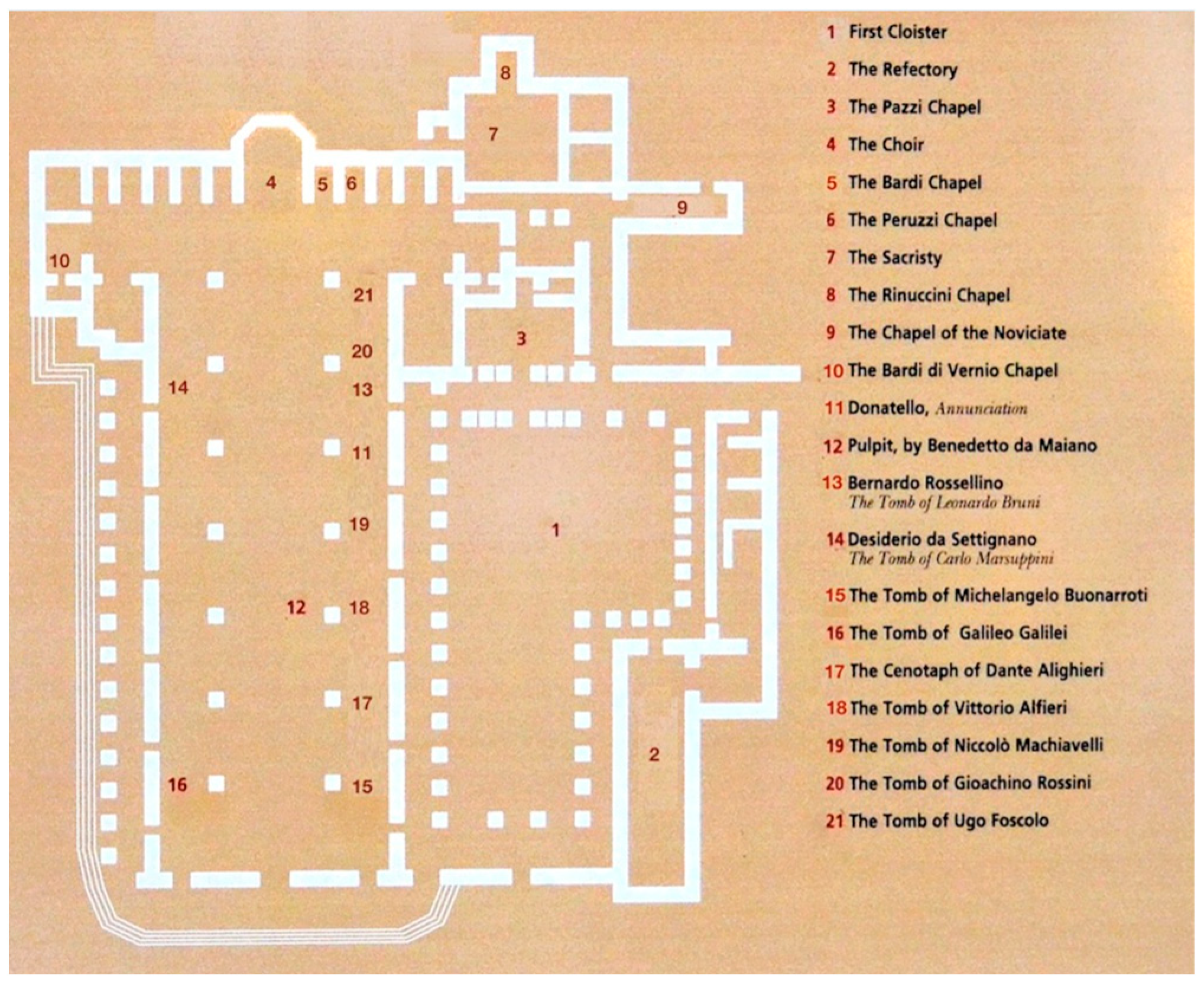
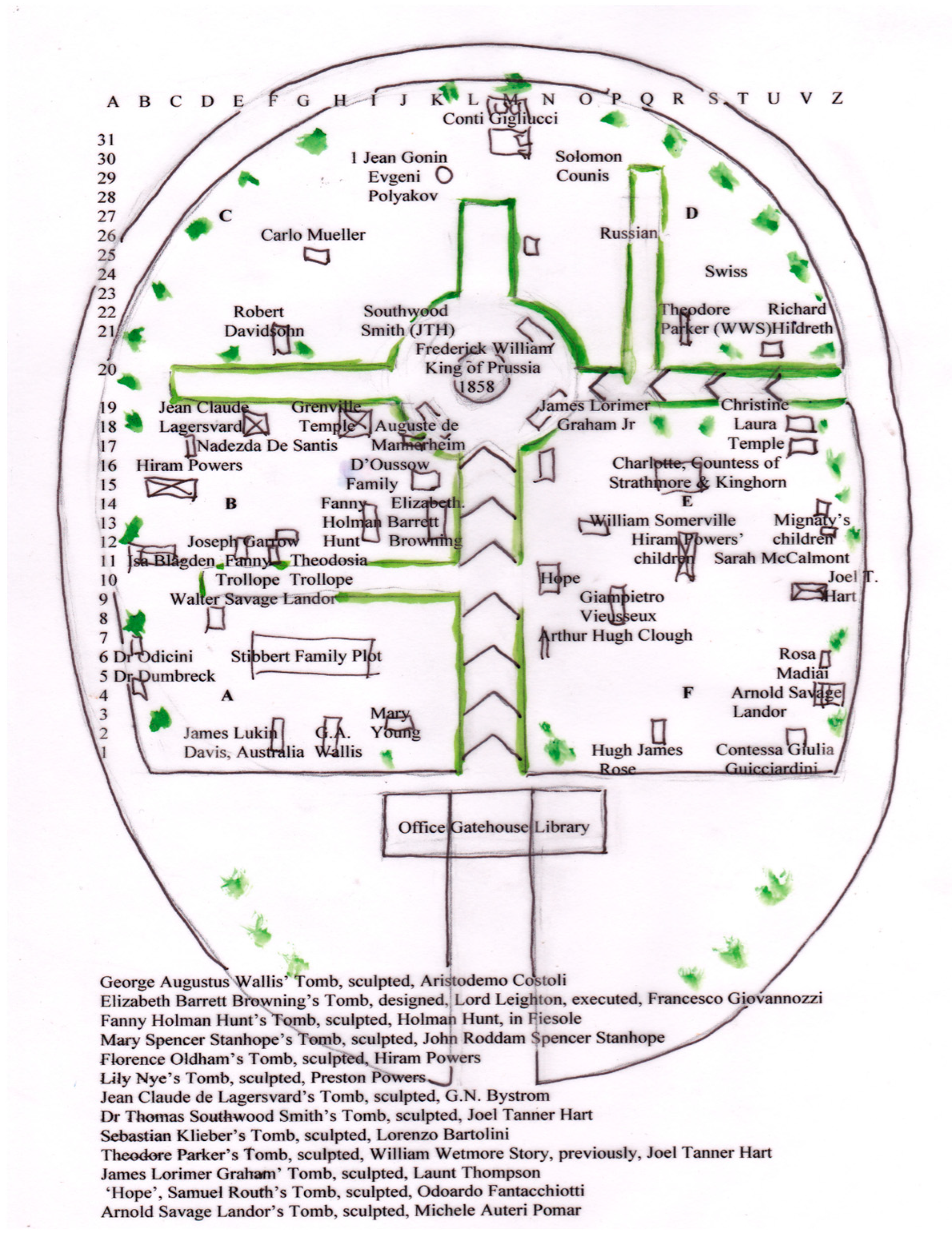
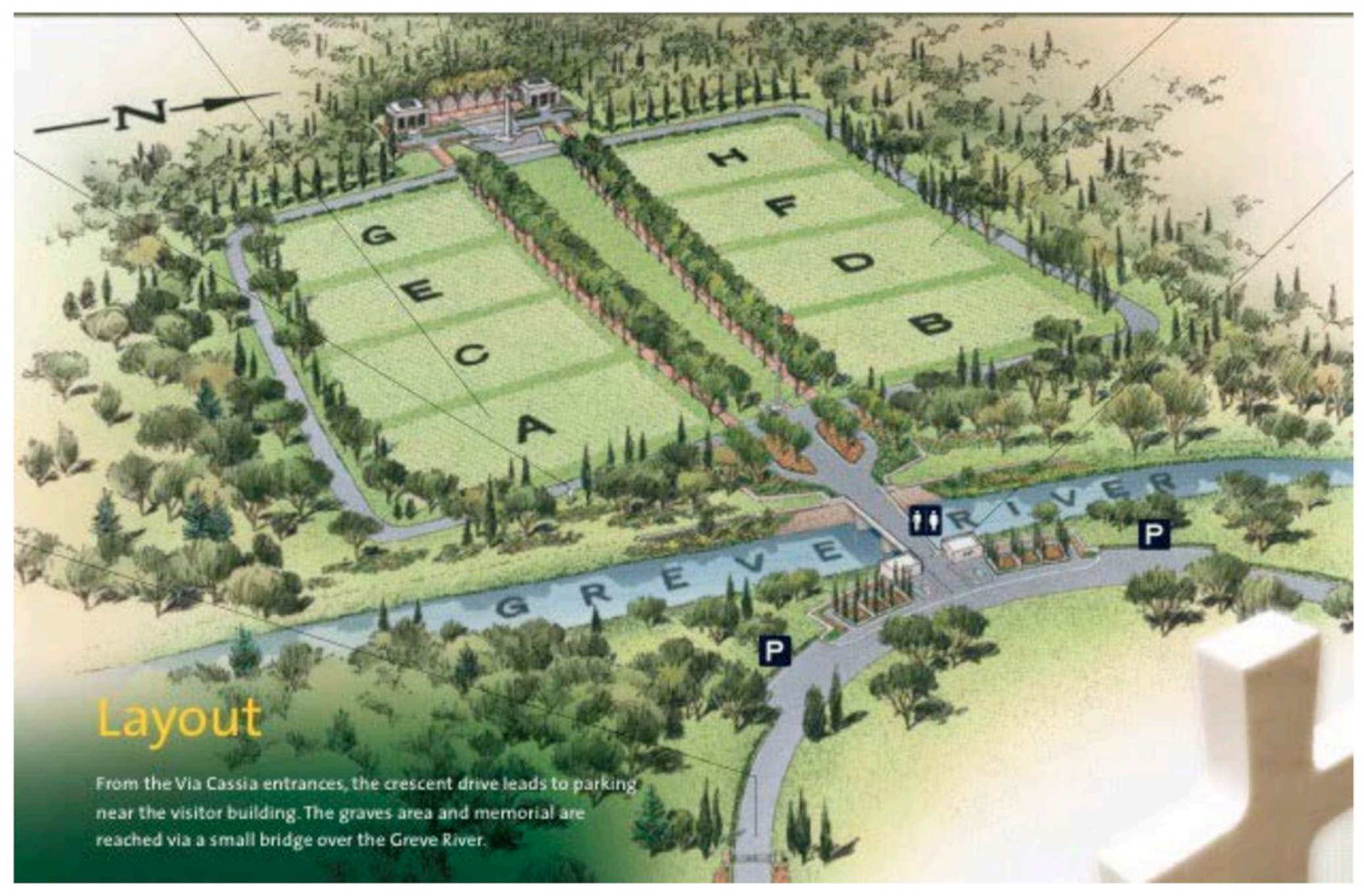

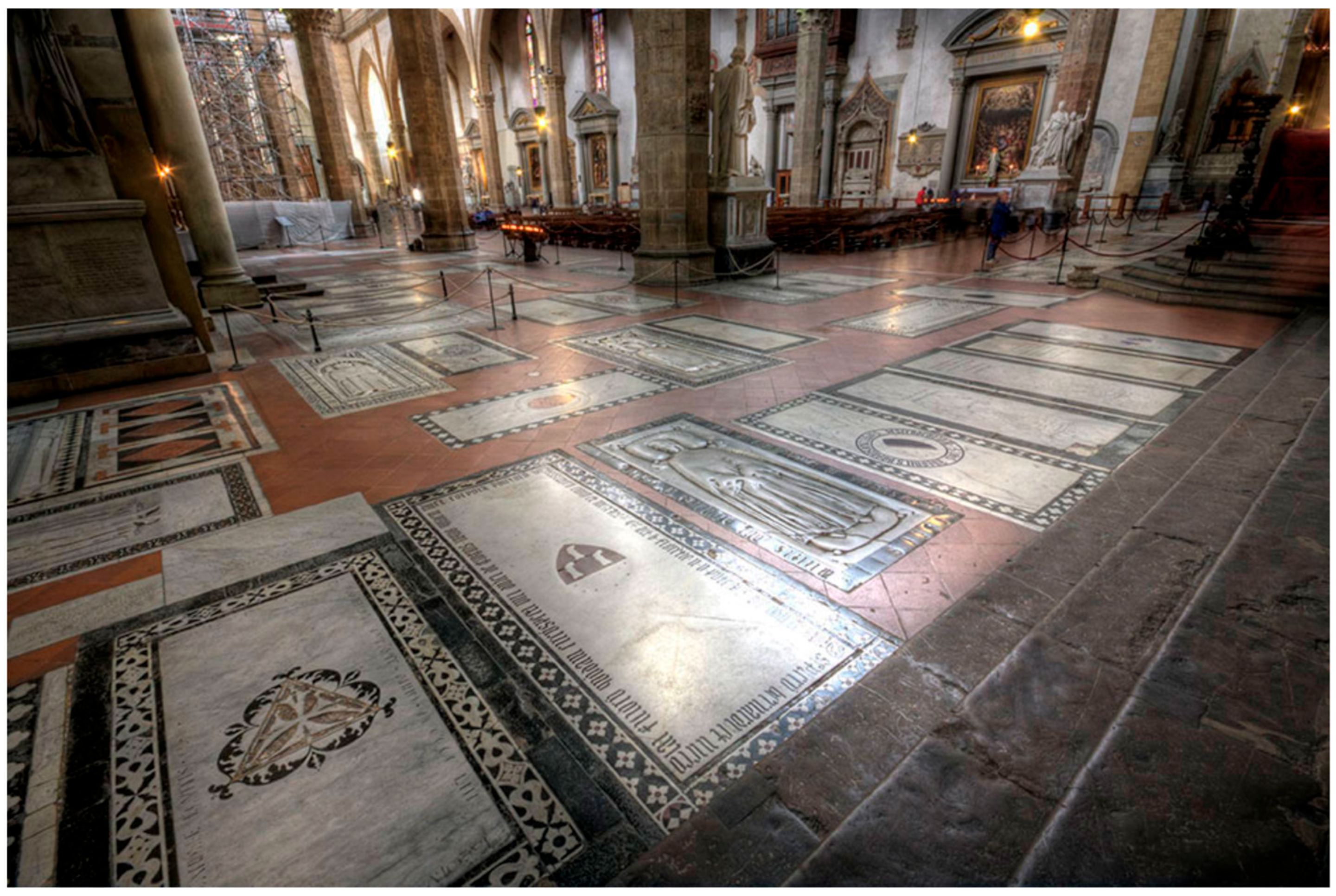

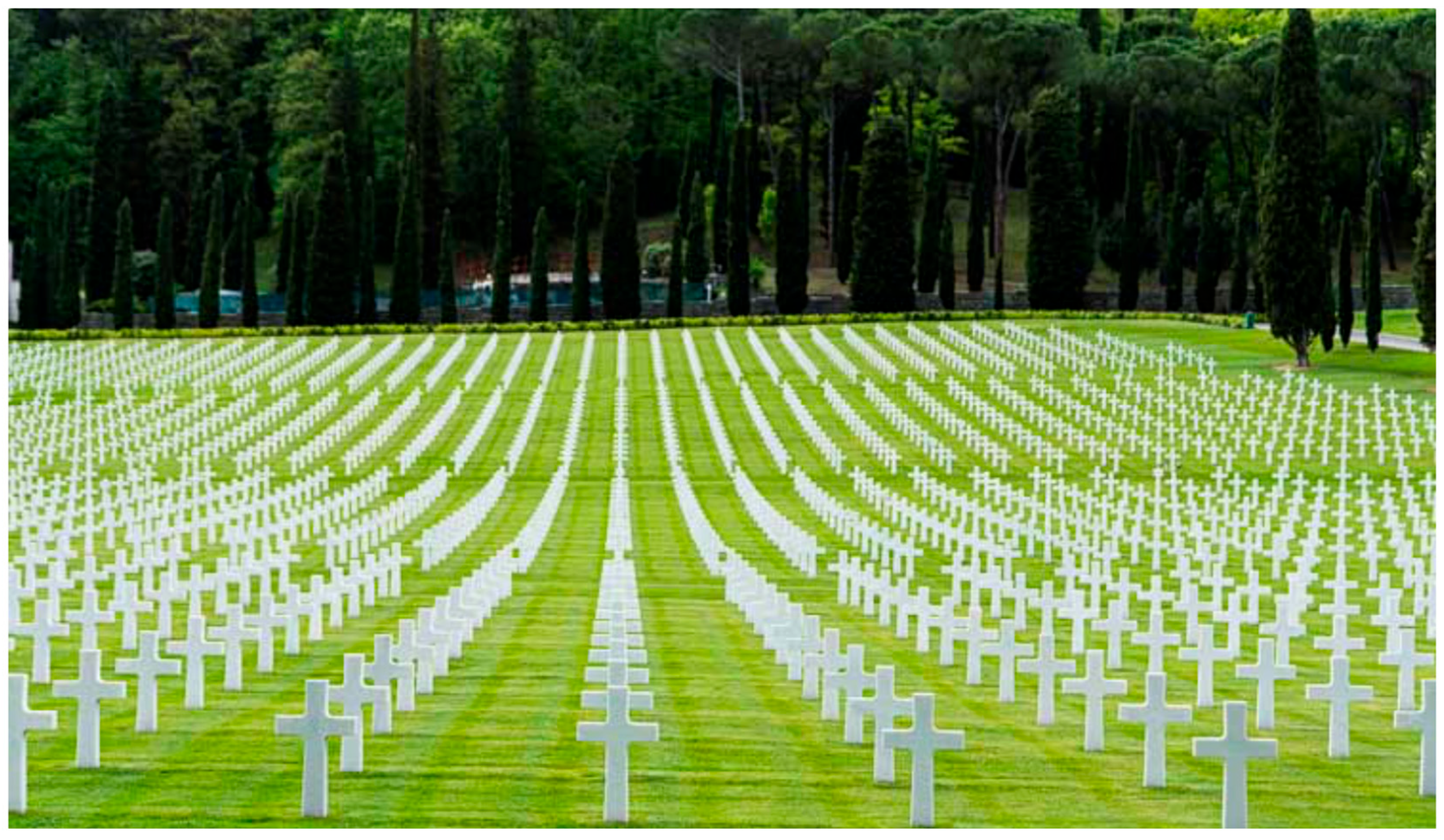
| Tree | Associated Figures | Symbolic Core | Cultural Functions |
|---|---|---|---|
| Laurel | Apollo, Augustus | Poetic immortality, transformation | Crowning poets and victors; imperial symbolism; ritual purification |
| Cypress | Hades, Anchises (via Aeneas) | Mourning, sacred transition | Necropolis design; ritual boundary marking; funerary architecture |
| Oak/Holm Oak | Zeus, Jupiter | Strength, civic justice, divine wisdom | Sacred groves; civic rituals (e.g., corona civica); markers of legal and sacred order |
| Site | Governance | Vegetation | Civic Engagement | Touristic Functions |
|---|---|---|---|---|
| Santa Croce | Opera di Santa Croce; municipal heritage | Laurel, ornamental cypress | Commemorations, educational visits | National memory, cultural tourism |
| English Cemetery | Swiss Evangelical Church; volunteers | Cypress, laurel, ivy | Gardening programs, school partnerships | Romantic heritage, literary routes |
| Florence American Cemetery | American Battle Monuments Commission (ABMC) | Cypress, holm oak, ornamental laurel | Memorial ceremonies, interpretive tours | Military heritage, educational tourism |
| Analytical Category | Guiding Questions | Key Indicators | Evaluative Notes (Descriptive Scale) |
|---|---|---|---|
| Botanical Symbolism | Which tree species are present? What cultural, mythological, or historical meanings do they carry? | Presence of laurel (Laurus nobilis), cypress (Cupressus sempervirens), holm oak (Quercus ilex); references to Ovid, Virgil, Pliny, etc. | Strong presence where arboreal symbolism is consistent and explicit; partial presence where species occur without strong symbolic integration; weak presence where symbolism is minimal or absent |
| Commemorative Function | What forms of memory making are expressed in the site? How is remembrance socially and ritually enacted? | Epitaphs, rituals, ceremonies, civic values, poetic legacy | Satisfactory where commemorative layers are rich and multi-scalar; partially satisfactory where limited or restricted to elite burials; unsatisfactory where ritual/social functions are minimal |
| Spatial and Esthetic Design | How is the space organized? How do natural and built elements interact? | Pathways, symmetrical layouts, integration of vegetation and architecture | Strong coherence where spatial order reinforces symbolic and commemorative functions; partial coherence where design is fragmented; weak coherence where integration is absent or minimal |
| Site | Date/Period | Commemorative Intent | Symbolic Flora | Social/Memory Politics | Planning Implications |
|---|---|---|---|---|---|
| Santa Croce (Basilica and Memorial Complex) | Medieval origins; expanded as national pantheon in 19th c. | Civic and national commemoration of artistic and scientific greatness | Minimal/absent (stone and sculpture dominate) | National identity, patriotic myth-making, civic pride | Supports cultural tourism centered on monumental heritage; requires careful visitor management to avoid overtourism in the historic core |
| English Cemetery | Established 1827 (Romantic period) | Cosmopolitan mourning, literary and artistic memory | Cypress (Cupressus sempervirens), laurel (Laurus nobilis), ivy (Hedera helix) | Romantic individualism, transnational cultural exchange | Expands cultural itineraries beyond the historic center; offers reflective, slow-tourism experiences; potential for heritage education and intercultural dialog programs |
| Florence American Cemetery | Established 1945 (post-WWII); dedicated 1960 | Commemoration of U.S. soldiers fallen in Italy | Cypress (Cupressus sempervirens), holm oak (Quercus ilex), laurel (Laurus nobilis) | Transnational diplomacy, collective sacrifice, Cold War-era symbolic politics | Integrates into peri-urban green infrastructure; exemplifies heritage landscapes with ecological services; potential model for combining remembrance with sustainable territorial planning |
Disclaimer/Publisher’s Note: The statements, opinions and data contained in all publications are solely those of the individual author(s) and contributor(s) and not of MDPI and/or the editor(s). MDPI and/or the editor(s) disclaim responsibility for any injury to people or property resulting from any ideas, methods, instructions or products referred to in the content. |
© 2025 by the author. Licensee MDPI, Basel, Switzerland. This article is an open access article distributed under the terms and conditions of the Creative Commons Attribution (CC BY) license (https://creativecommons.org/licenses/by/4.0/).
Share and Cite
Olivadese, M. Gardens of Memory as Cultural Landscapes for Sustainable Destination Planning. Tour. Hosp. 2025, 6, 174. https://doi.org/10.3390/tourhosp6040174
Olivadese M. Gardens of Memory as Cultural Landscapes for Sustainable Destination Planning. Tourism and Hospitality. 2025; 6(4):174. https://doi.org/10.3390/tourhosp6040174
Chicago/Turabian StyleOlivadese, Marianna. 2025. "Gardens of Memory as Cultural Landscapes for Sustainable Destination Planning" Tourism and Hospitality 6, no. 4: 174. https://doi.org/10.3390/tourhosp6040174
APA StyleOlivadese, M. (2025). Gardens of Memory as Cultural Landscapes for Sustainable Destination Planning. Tourism and Hospitality, 6(4), 174. https://doi.org/10.3390/tourhosp6040174






